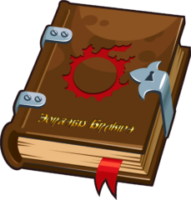From ‘Thoughts on the Primals – Malignant Divinity’ by Archon Niniri Niri
Ifrit, the deity of the Amalj’aa, is a terrifying entity, demonic even by the admission of his worshippers. With claws that melt iron, a breath that sears flesh and horns that sear the sky, Ifrit is commonly conceived of by scholars as a personification of the rage experienced by the Amalj’aa resulting from the settling of their holy lands by Ul’dah. If this is taken to be true, the berserker rage of Ifrit makes plenty of sense. Ifrit has traditionally been summoned in an area known as the Bowl of Embers, a basin of rock and sand nearby Zanr’ak that is colossally overaspected to the element of fire, resulting in constantly flickering flame and a general ambient heat
The religious doctrine of the Amalj’aa holds that Ifrit was the original being of the world, and that he created the world and populated it with lowly beasts who fought amongst each other constantly. Ifrit grew enamored with one of these races, great lizards possessed of immense ferocity. Ifrit reached out to them, granting them slivers of his own flame, which transformed fourteen of the lizards into the first Amalj’aa, seven men and seven women, who went on to found the seven tribes of their species. The location in which this blessing was imparted was named Zanr’ak but all was not well, as the powers of Thanalan have long claimed the region, both Belah’dia and Ul’dah.
The Lord of the Inferno’s Abilities – As one might expect from a primal summoned by a warrior culture and formed out a desire for reconquest, Ifrit is a terrifying force in combat. His breath is capable of ‘incinerating’ flesh and his mastery of fire aether is such that he can reach beneath the earth and stimulate the aether deep below, driving it upwards in an explosive gout, mimicking the ‘eruption’ of a volcano. Ifrit is also capable of forming solid structures of fire aether, named ‘infernal nails’ in the scriptures of the Amalj’aa, the function of which is unclear but it may be intended to draw fire aether from below the earth to the primal, that he might unleash the ‘hellfire’ of his wroth. The god-beast is possessed of holy fire, and is able to summon it forth in large ‘radiant plumes’ that roar with power.
The Amalj’aa are desert-dwellers, and thus wind is important to their culture. In reflection of this, Ifrit is able to meld flame and wind aether in bursts of ‘searing wind’ that gathers around a foe, wracking their flesh and eventually bursting forth in a flaming gale. The flame of Ifrit’s anger is not merely physical however, and it can afflict a kind of ‘suppuration’, or aether sickness, in a target to weaken them. As being more of aether than of mundanity, Ifrit proved able to divide himself into fragments, which then rushed forth in a hail of flame that resembled a great ‘crimson cyclone’.
Real World Basis – Ifrit’s name directly draws from the ifrit or efreet, a form of demon in Islamic religion. Their name is drawn from the phrase’ to roll into dust’ or عفر, a phrase that is often used to refer to a cunning or sly individual. In the scriptures of Islam, the ifrits were a form of jinn, a classification of spirits but they feature more prominently in the folklore than true scripture. They are often regarded negatively in folklore, but rarely as objectively evil creatures. They are commonly regarded as spirits of fire and smoke, a fact that has become true in Final Fantasy and, of course, XIV.




Leave a Reply